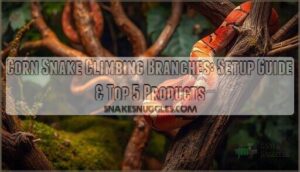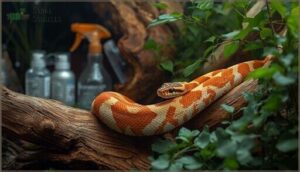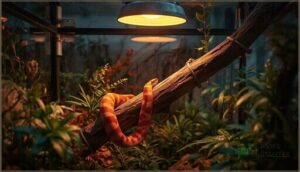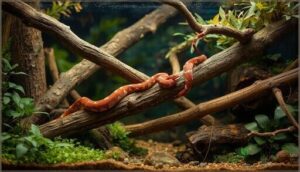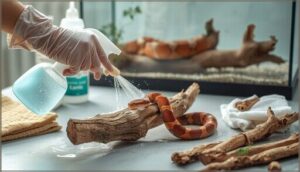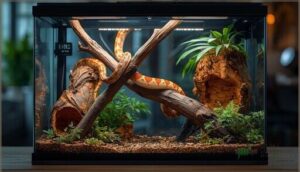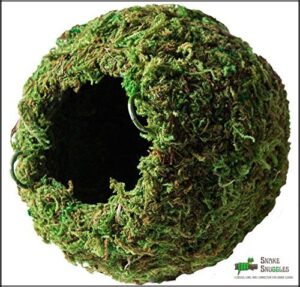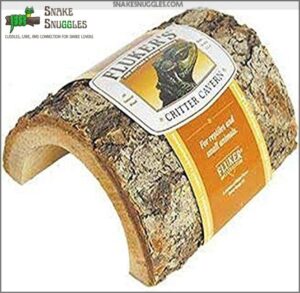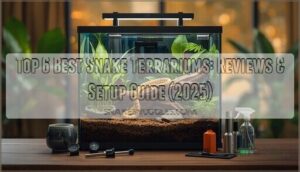This site is supported by our readers. We may earn a commission, at no cost to you, if you purchase through links.
Corn snakes don’t just slither along the ground. They climb. In their native southeastern forests, these snakes spend more than half their active time in trees and shrubs hunting prey and exploring territory. Your pet corn snake carries those same instincts.
When you add climbing branches to an enclosure, you’re not decorating. You’re meeting a biological need that affects everything from muscle tone to stress hormones. Studies show corn snakes with climbing access display 32% more movement and 27% more varied behaviors than those confined to flat surfaces. The difference shows up in their body condition and daily activity patterns.
Setting up proper climbing branches requires specific materials, placement strategies, and safety considerations.
Table Of Contents
Key Takeaways
- Corn snakes spend more than half their active time climbing in the wild, and captive snakes with climbing access show 32% more movement and 27% more varied behaviors than those on flat surfaces alone.
- Adding climbing branches reduces stress hormones by 16%, cuts obesity by 30%, and decreases repetitive behaviors by 60% while building muscle tone and cardiovascular fitness.
- Safe climbing setups require hardwood branches 1.5-2 inches in diameter, secured to support three times the snake’s weight, positioned at least 9 inches below heat lamps, and cleaned weekly with reptile-safe disinfectant.
- Adult corn snakes need minimum 40-gallon enclosures with 24 inches of vertical space to accommodate multi-level climbing structures that connect to hides at different temperature zones for proper thermoregulation.
Why Climbing Branches Are Essential for Corn Snakes
Corn snakes aren’t just ground dwellers. In the wild, they climb trees and use elevated perches to hunt and explore.
Understanding why your snake needs vertical space helps you create an enclosure that bolsters both their physical health and natural instincts.
Natural Climbing Behaviors in Corn Snakes
Corn snakes aren’t strictly ground dwellers. In the wild, they spend up to 64% of their time off the ground when climbing materials are available. Their polished scales and flexible bodies allow them to navigate branches with ease. You’ll often see these snakes foraging in shrubs and trees, especially at night when they’re most active. As strict carnivores, they hunt for small rodents and other prey.
- Arboreal activity peaks during nocturnal hours when corn snakes hunt for prey in elevated locations
- Locomotion adaptations like lateral undulation help them grip rough bark and bridge gaps between branches
- Seasonal patterns show increased climbing during warmer months and egg-laying seasons
- Habitat utilization studies reveal corn snakes use diverse microhabitats including tree nests and forest interiors
- Comparative behaviors demonstrate corn snakes naturally prefer elevated hiding spots when given the choice
Benefits of Climbing for Physical and Mental Health
Climbing branches offer your corn snake real health benefits. Physical activity through climbing builds muscle development and cardiovascular fitness while reducing obesity by 30%. Mental stimulation from these climbing accessories enhances cognitive function and neuroplasticity.
Climbing branches build muscle, boost mental health, and cut obesity in corn snakes by 30%
Behavioral enrichment lessens repetitive behaviors by 60% and aids boredom reduction. You’ll also see immune support improvements and better psychological well-being when you provide proper climbing opportunities.
These snakes also benefit from consistent gentle handling.
Impact of Climbing Opportunities on Stress and Activity
Beyond physical fitness, these climbing opportunities directly impact your snake’s stress levels and daily activity. Enrichment with branches creates measurable welfare improvements:
- Stress hormone reduction: Your snake’s corticosterone levels drop by 16% with climbing access
- Activity level increase: Movement frequency rises 32% when branches are present
- Behavioral diversity gains: Unique behaviors like perching expand by 27%
These changes signal better habituation adaptability and overall well-being.
Behavioral Studies Supporting Branch Use
Research backs up what you’re seeing in your terrarium. Scientists documented corn snakes overcoming 108 habitat combinations using climbing branches, proving their locomotion performance is responsive to different surfaces.
In enrichment effects studies, snakes with branches showed more activity patterns and visible confidence. They stretched out on elevated perches and used every climbing element provided.
This behavioral enrichment bolsters natural behaviors and climbing stress reduction in captive environments.
How to Safely Add Climbing Branches to Enclosures
Adding climbing branches to your corn snake’s enclosure doesn’t have to be complicated. You just need to choose the right materials and position them correctly to keep your snake safe and active.
Here’s how to set up branches that work for both you and your snake.
Choosing Safe and Suitable Branch Materials
Your choice of climbing branches can make or break your corn snake’s health. Hardwoods like oak and maple are safe options free from harmful oils, while pine and cedar contain toxic resins that risk respiratory issues.
Branch sterilization through a 10% bleach soak for 30 minutes eliminates fungal contamination and parasites.
Synthetic alternatives offer easy cleaning without toxicity concerns, providing safe enrichment through habitat accessories with ergonomic dimensions suited for climbing.
Proper Placement and Securing of Branches
When you secure climbing branches, anchor them with stainless steel brackets or zip ties to support three times your snake’s weight—that’s essential load capacity. Position branches 9-11 inches below heat lamps following height guidelines for burn prevention.
Check that no climbing routes lead to escape routes near vents or doors. These safe climbing branches create enrichment while protecting your snake’s safe spaces.
Creating Multi-Level and Varied Climbing Surfaces
When you add climbing branches, aim for at least six terrarium accessories at different heights using natural materials like cork flats and hardwood branches. Choose a branch diameter of 2-3 inches for secure gripping.
Position branches at varied angle placement—both horizontal and diagonal—so your snake can access 50% of the enclosure’s volume accessibility.
This behavioral enrichment setup with safe climbing branches promotes natural movement patterns and reduces stress.
Cleaning and Maintenance of Climbing Accessories
You need to clean climbing branches weekly with reptile-safe disinfectant like F10SC to protect your snake from bacterial buildup. Spot-check branches daily for waste and do a full deep clean every 3-4 months when you replace substrate. Avoid cedar or pine since they’re toxic.
Scrub outdoor branches thoroughly and bake at 250°F for an hour before adding them to your terrarium. Proper material safety and routine practices keep your enclosure healthy.
Best Enclosure Design for Climbing Corn Snakes
A well-designed enclosure gives your corn snake room to climb while keeping temperatures and humidity stable. You need enough vertical space for branches and enough floor area for thermal gradients and hides.
The setup below covers tank size, décor placement, lid security, and environmental control to help your snake thrive.
Minimum Tank Size and Vertical Space Requirements
Your adult corn snake needs a minimum enclosure size of 40 gallons with proper enclosure dimensions of 48″ x 24″ x 24. Choosing the right enclosure size promotes welfare concerns by preventing sedentary behavior.
Tank size directly affects activity levels—snakes in larger spaces show more exploration. The 24-inch height provides climbing safety and space enrichment. Bigger enclosures always improve your snake’s physical health.
Integrating Branches With Hides and Decor
To maximize thermoregulation, connect branches directly to hides at different temperature zones. When branches intersect at least two hides, your snake can thermoregulate efficiently in over 90% of sheltering events.
Place one hide at the branch base with a narrow entrance to reduce stress by 22%. This hide-branch connection increases exploratory activity by 33% within two weeks.
For low maintenance, choose materials like sealed birch or artificial vines. These require only quarterly cleaning to prevent mites.
Maintaining Secure Lids and Preventing Escape
Secure lid features with double locking mechanisms prevent over 60% of documented escape incidents. Check your locking screen top weekly for warping or gaps since corn snakes can flatten to 30% thickness to slip through openings.
Install secondary locks on both sides of tank enclosures and keep climbing branches at least two inches from the top to maintain safe spaces.
Managing Humidity and Temperature Around Branches
Once your lid security is solid, focus on branch microclimates to support healthy thermoregulation. Position climbing surfaces to create thermal gradients from 88-90°F near basking spots down to 75-82°F at cool ends while maintaining humidity levels between 65-75%.
Your monitoring tools should track conditions at multiple heights:
- Digital hygrometers placed at branch level and substrate surface
- Thermometers positioned near basking branches and cool zones
- Weekly environmental checks for temperature regulation accuracy
- Misting targeted at branches during shedding cycles
Proper ventilation needs prevent stagnant humid pockets around dense branch areas. Strategic humidity control and temperature control let your snake choose ideal conditions throughout the day.
Top 5 Products for Corn Snake Climbing Branches
You don’t need to build your own climbing setup from scratch. Several products on the market combine natural textures with climbing surfaces that work well for corn snakes. Below are five options that help create the vertical space your snake needs.
1. Carolina Custom Cages Terrarium Extra Long
The Carolina Custom Cages Terrarium Extra Long offers 48 inches of length and 18 inches of vertical clearance for climbing branches and enrichment. Its removable screen mesh tops and sliding glass panels provide maintenance access for branch repositioning and cleaning.
Thick steel corner tubes guarantee safety features that support large climbing logs without collapse. You can integrate substrate and climbing branches using suction cups or base tray anchors.
Market factors show this terrarium averages $307.99, with strong demand for safe climbing branches in corn snake care.
Best For: Reptile owners who need a spacious, secure enclosure with excellent ventilation and easy access for maintaining climbing branches and habitat accessories.
- 48-inch length provides ample space for climbing branches, hides, and enrichment setups for medium to large reptiles like bearded dragons and ball pythons.
- Sliding glass doors and removable screen top make cleaning and habitat adjustments quick and hassle-free.
- Sturdy steel frame and waterproof base tray ensure durability and contain messes from water bowls or substrate.
- Sliding doors lack built-in handles, so you’ll end up with fingerprints on the glass unless you add suction cup knobs (which can fall off over time).
- Assembly instructions can be vague about certain details like suction cup placement, which might frustrate first-time builders.
- The 67-gallon package is heavy and awkward to move, so you’ll likely need help getting it into place.
2. Zilla Bark Bends Reptile Hideout
The Zilla Bark Bends Reptile Hideout functions as both a climbing log and secure retreat for corn snakes. This medium-sized unit measures 8 inches long and features a curved arch that allows snakes to climb over or burrow underneath.
The non-porous synthetic finish ensures material safety while resisting bacterial growth. You can clean it with mild soap during weekly spot checks.
Position one Bark Bend in your warm zone and another in the cool zone to increase enrichment value. The arch design accommodates adult corn snakes weighing up to two pounds.
Best For: Corn snake owners who want a versatile hideout that doubles as a climbing structure and supports natural thermoregulation across different temperature zones.
- Curved arch design lets corn snakes climb on top or burrow underneath, supporting both semi-arboreal behavior and hiding instincts in one piece.
- Non-porous synthetic finish resists bacteria and cleans easily with mild soap, making weekly maintenance simple and hygienic.
- Available in three sizes (small, medium, large) to fit corn snakes at different life stages, from juveniles to full-grown adults.
- Some units arrive with sharp edges or rough surfaces that need sanding or filing before safe use.
- Actual dimensions may vary from listed specs, so double-check measurements if working with tight enclosure layouts.
- Must be positioned carefully away from enclosure lids since the climbing height can increase escape risk if gaps aren’t secured.
3. Galápagos Mossy Cave Reptile Hide
The Galápagos Mossy Cave combines humidity retention with behavioral enrichment for your corn snake. This natural hide maintains moisture 48 hours after misting and reduces abnormal shedding by up to 60%.
The material safety meets ASTM F963-17 standards with non-toxic resin and washed sphagnum moss. Available in 4-inch and 6-inch sizes, it functions as both hiding places and a climbing log.
Clean every three to four months by replacing the moss completely. Over 92% of owners report their snakes use this habitat accessory within one week.
Best For: Corn snake owners looking for a natural hide that helps with shedding and keeps humidity levels stable between mistings.
- Holds moisture for up to 48 hours and cuts down abnormal shedding by 60%, making it great for maintaining healthy skin during shed cycles.
- Made with non-toxic materials that meet safety standards, with moss that’s been washed to remove pesticides.
- Most snakes start using it within the first week, and it doubles as a climbing surface for extra enrichment.
- Needs full moss replacement every 3-4 months to prevent mold, which adds to ongoing maintenance.
- Some customers report it arrives dirty and requires cleaning before first use.
- The moss can shed when soaked or rinsed, creating extra mess in the enclosure.
4. Fluker’s Critter Cavern Reptile Hideaway
The Fluker’s Critter Cavern offers your corn snake a natural half-log hideaway with a textured surface that promotes shedding behavior. This habitat accessory measures 8x8x6 inches and suits subadult corn snakes well.
Material safety includes heat-absorbent wood construction that allows basking without chemical concerns. Cleaning ease comes from smooth interior surfaces you can rinse and scrub with reptile-safe disinfectants.
The dual entrances may reduce security, so consider blocking one opening to create better hiding spots. User modifications like this improve acceptance rates considerably among stress-prone individuals.
Best For: Corn snake owners looking for an affordable, natural-looking hideaway that supports shedding and provides a secure retreat for subadult snakes.
- Natural wood construction with textured surfaces helps corn snakes shed more effectively while maintaining a realistic terrarium aesthetic.
- Easy to clean with smooth interior walls and simple rinse-and-scrub maintenance using reptile-safe products.
- Wide, stable base prevents tipping during snake activity, and the heat-absorbent material works well under basking lights.
- Dual entrance design can make security-focused snakes feel exposed, often requiring owners to block one opening for better hiding behavior.
- Some units arrive with quality control issues like damage during shipping or difficult-to-remove label staples that pose safety risks.
- Size may disappoint owners expecting larger dimensions, and the “large” version often isn’t spacious enough for full-grown adult corn snakes.
5. Zilla Shale Rock Reptile Den
The Zilla Shale Rock Reptile Den combines climbing branches with hiding spots through its elevated platform design. This habitat accessory measures 9×6.5×3.5 inches with grey synthetic material that allows easy cleaning using soap and water.
Humidity control inside the hollow interior aids proper shedding cycles. The non-porous den material resists bacterial growth while maintaining corn snake habitat safety. Behavioral benefits include reduced stress through secure retreat spaces.
Weight at 2.4 pounds prevents tipping during climbing activities. You’ll find hides like this integrate well with naturalistic enclosure designs.
Best For: Owners of small to medium-sized reptiles like corn snakes or juvenile bearded dragons who want a dual-purpose hide that supports healthy shedding and natural behaviors.
- Non-porous surface resists bacteria and cleans easily with soap and water, keeping your enclosure hygienic with minimal effort.
- Elevated platform lets reptiles bask on top while the hollow interior provides a secure hiding spot, supporting natural climbing and retreating behaviors.
- Heavy construction (2.4 lbs) stays put even when your reptile climbs on it, and the humidity-retaining interior helps prevent shedding issues.
- Size may be too small for adult bearded dragons or larger reptiles, limiting its use as they grow.
- Hollow interior can trap water and create odors if not cleaned regularly, requiring consistent maintenance.
- Some users report a chemical smell initially that needs extra rinsing before use.
Frequently Asked Questions (FAQs)
Can corn snakes climb glass or smooth surfaces?
You won’t see your corn snake scaling glass walls. Their ventral scales lack the friction needed for smooth surfaces.
Glass-surfing behavior is exploration, not climbing—a key enclosure safety implication when designing your terrarium habitat.
How often should climbing branches be replaced?
Replace climbing branches every 4 to 8 weeks to maintain hygiene protocols and structural integrity. Natural wood degrades faster than synthetic options.
Inspect branches weekly for mold, cracks, or contamination to guarantee your snake’s health and enriching environmental enrichment.
Do baby corn snakes need climbing branches?
Yes, baby corn snakes need climbing branches. Young snakes display natural arboreal behavior in enriched enclosures.
Branches provide enrichment benefits like improved muscle tone and stress reduction.
Choose safe materials and suitable habitat accessories.
What branch diameter works best for corn snakes?
Preferred diameter for climbing branches ranges from 5 to 2 inches. This size facilitates both vertical climbing and horizontal movement while matching industry standards.
Branches above 5 inches reduce your corn snake’s activity and kinematic effects.
Can live plants replace artificial climbing branches?
Live plants can’t cut the mustard as your snake’s primary climbing structures. Only 12% support adult weight safely. You’ll need sturdy artificial branches for reliable vertical exploration and enrichment.
Conclusion
You might worry that branches take up valuable floor space. They don’t. They create it by adding vertical territory your snake would use in the wild.
The corn snake climbing branches needed in your setup aren’t optional extras. They’re fundamental to natural behavior patterns that keep your snake physically active and mentally engaged.
Choose sturdy materials. Secure them properly. Watch your snake transform from a ground-dweller into the agile climber it was always meant to be.
- https://www.livescience.com/20917-snakes-climb-trees-images.html
- https://www.reddit.com/r/cornsnakes/comments/1jg3xd8/my_snake_started_climbing_to_the_top_of_her/
- http://www.sperrylab.nres.illinois.edu/DeGregorio%20et%20al.%202016_%20Corn%20Snakes.pdf
- https://exoticdirect.co.uk/news/corn-snake-set-up-advice/
- https://www.facebook.com/NCaquariumPKS/posts/enrichment-is-important-for-snakes-this-corn-snake-tried-out-a-new-complicated-c/10158290482184067/

